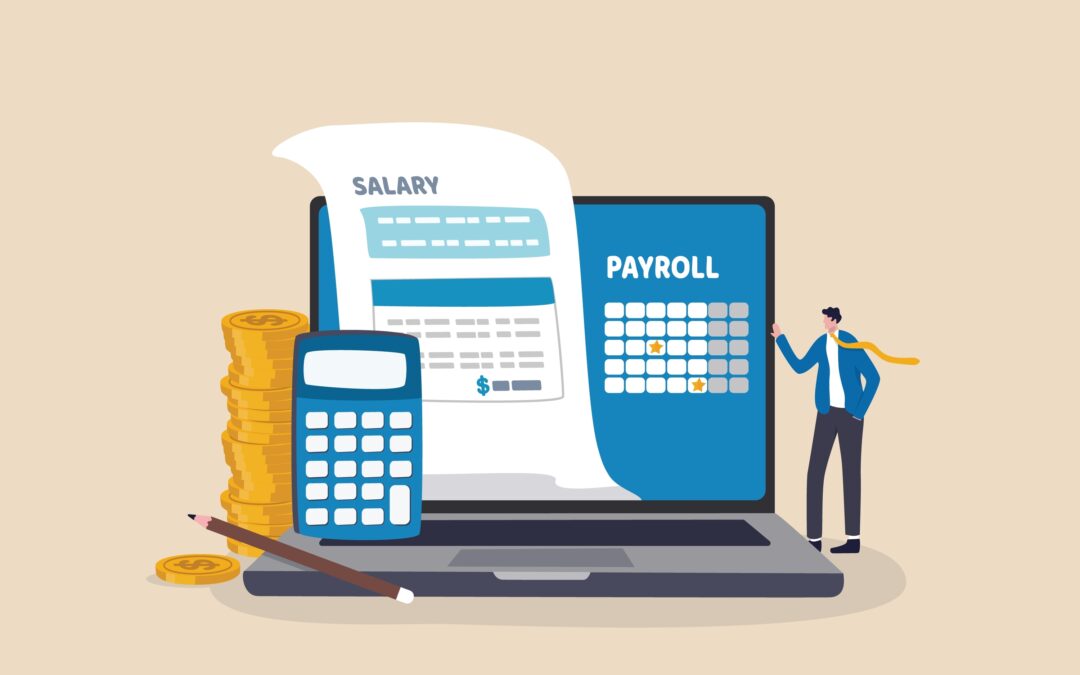
Compliance, Guide
Did you know that small business owners spend an average of eight hours a month just on payroll processing? With compliance laws changing constantly, it can be tough to keep up. In fact, according to the Society for Human Resource Management, compliance with federal, state, and local laws is the top HR challenge for businesses.
As a small business owner or HR professional, payroll compliance is crucial to avoid costly penalties and legal issues. However, with so many laws and regulations to navigate, it can be overwhelming. That’s why we’ve put together this comprehensive guide to help you understand the basics of payroll compliance.
Federal Payroll Laws:
- Fair Labor Standards Act (FLSA): sets minimum wage, overtime pay, record-keeping, exemption status, and child labor standards for most employees in the private and public sectors.
- Federal Insurance Contributions Act (FICA): requires employers and employees to contribute to Social Security and Medicare.
- Federal Unemployment Tax Act (FUTA): requires employers to pay unemployment taxes, which go into a fund that provides benefits to eligible workers who lose their jobs.
State Payroll Laws:
- Minimum Wage: many states have their own minimum wage laws, which may be higher than the federal minimum wage.
- Overtime: some states have their own overtime laws, which may be more generous than federal law.
- Income Tax Withholding: most states require employers to withhold state income tax from employee paychecks.
- Unemployment Insurance: states have their own unemployment insurance programs, which employers must contribute to.
Local Payroll Laws:
- Paid Sick Leave: some cities and states require employers to provide paid sick leave to employees.
- Fair Workweek: some cities require employers to provide advance notice of work schedules and/or provide additional pay if schedules are changed at the last minute.
- Wage Theft Prevention: some cities require employers to provide notice to employees of their rights to minimum wage and overtime pay.
- Predictive Scheduling: some cities require employers to provide advance notice of schedules for hourly employees.
It’s important to note that these laws can vary widely from state to state and city to city. Employers need to be aware of the specific laws that apply to their business and ensure that they are in compliance. This may involve working with an HR consultant or payroll provider to ensure that payroll processing is accurate and that all necessary taxes and other deductions are being taken out of employee paychecks.
Tips for Ensuring Payroll Compliance:
- Stay up-to-date on changes in payroll laws: Payroll laws are constantly changing, so it’s important to stay informed about new laws or changes to existing ones. Subscribe to newsletters from government agencies, attend webinars or conferences, and stay in touch with industry associations to stay informed.
- Establish a payroll compliance checklist: Create a checklist of all the payroll tasks that need to be completed to ensure compliance. This should include things like verifying employee information, calculating taxes and deductions, and submitting payroll taxes on time.
- Train your payroll staff: Make sure your payroll staff is well-trained on all payroll laws and regulations that apply to your business. Provide regular training sessions and make sure they understand the importance of compliance.
- Use payroll software: Payroll software can help automate payroll processes and ensure compliance with payroll laws. Make sure you choose a software that is regularly updated to reflect changes in payroll laws.
- Perform regular audits: Regularly audit your payroll processes to ensure compliance. This can include reviewing payroll records, verifying employee information, and checking for errors or discrepancies.
- Seek professional help: If you’re not confident in your ability to manage payroll compliance on your own, consider hiring a professional to help. This could include a payroll consultant or a CPA who specializes in payroll.
By following these tips, you can help ensure compliance with payroll laws and avoid costly penalties and fines.
Key Takeaways Summary:
-
Payroll compliance is important for small business owners and HR professionals to avoid penalties and legal issues.
-
Federal, state, and local laws impact payroll compliance, and it’s important to be aware of the specific laws that apply to your business.
-
Staying up-to-date on changes in payroll laws, establishing a payroll compliance checklist, training your payroll staff, using payroll software, and performing regular audits can help ensure compliance.
-
Seeking professional help, such as a payroll consultant or CPA, can be an option for those who need additional support.
-
Accurate payroll processing and effective workforce management are key components of compliance.
Payroll compliance can be complex, but it’s essential for the success of your business. By understanding federal, state, and local laws, properly processing payroll, effectively managing your workforce, and engaging your employees, you can ensure compliance and avoid costly penalties. If your company still has payroll questions or concerns visit https://www.highflyerhr.com/contact-us/ today to see how we can make painroll painless!

Compliance
Did you know that small businesses pay an average of $845 per year in penalties for incorrect or late payroll tax filings and payments? Don’t let this be you. Read on for a guide on how to simplify your payroll tax processes.
Payroll tax filings and payments can be a headache for small business owners and HR professionals alike. With changing tax laws and regulations, it can be hard to keep up and ensure that your filings are accurate and timely. In this blog, we’ll break down the steps you need to take to simplify your payroll tax processes and avoid penalties.
In this blog post, we will guide HR professionals and small business owners on how to simplify their payroll tax filings and payments.
1. Understand Your Tax Obligations
Business owners need to understand their tax obligations to avoid errors and penalties. Start by researching which taxes you need to withhold and when to remit them. For example, federal income tax and Social Security tax have different deadlines for payment and filing. Familiarize yourself with federal and state tax laws, and stay up-to-date on any changes or updates. Additionally, you may want to consider consulting with a tax professional to ensure you’re meeting all obligations.
To fully understand your tax obligations, it’s important to keep up-to-date with any changes to tax laws and regulations. This means staying informed about new tax codes, deadlines, and other compliance requirements. You can stay informed by regularly checking the IRS website, attending tax seminars and conferences, or consulting with a tax professional. By staying informed, you can avoid costly penalties and minimize your risk of being audited.
2. Keep Accurate Records
Accurate record-keeping is essential for small businesses. Make sure you keep track of all employee information, including Social Security numbers, wages, and tax withholdings. Additionally, keep a copy of all tax filings and payments for at least four years, in case of an audit.
Consistent record-keeping is critical for payroll tax filings and payments. In addition to keeping track of employee information and tax withholdings, it’s important to keep detailed records of all payroll-related expenses, such as benefits and reimbursements. Make sure you have a system in place for tracking and organizing all payroll-related documents and receipts, such as timesheets, pay stubs, and tax forms. This will make it much easier to prepare and file your payroll tax returns
3. Remit Taxes on Time
Late or incorrect payroll tax payments can result in penalties and interest charges, so it’s important to remit taxes on time and in the correct amounts. You can also use the Electronic Federal Tax Payment System (EFTPS) to make federal tax payments, which is free and secure. Additionally, check with your state tax agency to see if they offer similar payment options.
To ensure you never miss a tax deadline, consider setting up automatic payments or reminders. This will help you stay on top of your payroll tax obligations and avoid costly penalties and interest charges. If you do miss a deadline or make a mistake on your tax return, don’t panic. You may be able to avoid penalties by promptly correcting the error and filing an amended return. Just be sure to take action as soon as possible to minimize the impact on your business.
4. Set Up a Payroll System
A payroll system can automate payroll calculations, tax withholdings, and reporting. Consider investing in payroll software, which can provide customized solutions for your business’s specific needs. Payroll software can also save you time and minimize errors, which can be costly in the long run. If you don’t want to invest in software, you can outsource your payroll to a third-party provider. This can also save time and money while ensuring that you’re meeting all tax obligations.
When setting up a payroll system, it’s important to consider the size and complexity of your business. If you have a small business with only a few employees, you may be able to handle payroll in-house using a simple spreadsheet. However, if your business is larger and more complex, you may want to consider investing in a more robust payroll software or outsourcing your payroll to a third-party provider. Look for a solution that offers features such as direct deposit, automatic tax calculations, and customizable reports.
Key Takeaways Summary:
-
Understand your tax obligations to ensure compliance
-
Keep accurate records for auditing purposes
-
Remit taxes on time to avoid penalties and interest charges
-
Set up a payroll system to automate calculations and minimize errors
Payroll tax filings and payments can be complicated, but by following these steps, HR professionals and small business owners can simplify the process and avoid costly penalties. Make sure to stay up-to-date on any changes to tax laws and regulations and invest in a payroll system to streamline your processes. With the right tools and knowledge, payroll tax filings and payments can be a breeze. Visit https://www.highflyerhr.com/contact-us/ or call (225) 930-8300 today to see how we can help!

Engaged Workforce
According to a recent Gallup poll, only 34% of U.S. employees are engaged at work, costing businesses an estimated $450-550 billion annually in lost productivity. As an HR or payroll professional, it’s crucial to understand why employee engagement is so important and how you can improve it in your workplace.
In today’s fast-paced business world, employee engagement has become a critical factor in achieving success. It’s no longer enough to simply provide employees with a paycheck and basic benefits. Companies must now focus on creating a positive work environment where employees feel valued, motivated, and invested in the company’s mission. This blog will explore the importance of employee engagement and provide practical tips for improving it in your workplace.
What is Employee Engagement?
Employee engagement refers to the extent to which employees are emotionally invested and committed to their work, their organization, and its goals. Engaged employees are passionate about their work, motivated to do their best, and feel a sense of ownership and responsibility for the success of the company. They have a positive attitude towards their job and are willing to go above and beyond what is expected of them.
The Cost of Disengaged Employees and the Benefits of Engaged Employees Disengaged employees can cost a company up to 34% of their salary in lost productivity, according to a Gallup study. On the other hand, engaged employees are 87% less likely to leave their company and are more likely to refer new talent to the company. By investing in employee engagement, companies can save money on recruitment and retain top talent, leading to increased profitability.
Effective Strategies for Improving Employee Engagement
Communication: Regularly communicate with employees through town hall meetings, team meetings, newsletters, and one-on-one conversations. Encourage open and honest feedback, and respond to employee concerns and suggestions in a timely manner.
Recognition: Develop a recognition program that rewards employees for their hard work and contributions. This could include awards, bonuses, public recognition, and other incentives.
Professional Development: Provide opportunities for employees to learn and grow in their roles through training programs, mentorship, and career development plans.
Work-Life Balance: Offer flexible work arrangements such as telecommuting, flexible hours, and paid time off. Encourage employees to take breaks and prioritize self-care.
Feedback: Provide regular feedback to employees about their performance and progress, and encourage them to provide feedback to management as well. Use employee surveys and other tools to gather feedback and track engagement levels.
Integrating Employee Engagement into HR and Payroll Practices
Recruitment: Develop a recruitment strategy that emphasizes engagement and culture fit, such as using behavioral interviewing techniques to identify candidates who are likely to be engaged and committed to the company’s values. Provide a positive candidate experience by communicating clearly about the company’s culture and values, and providing timely feedback throughout the hiring process.
Payroll and Benefits: Offer competitive compensation and benefits packages that align with employee needs and values. Consider offering flexible benefits options, wellness programs, and other incentives that support employee well-being and engagement.
Local HR Consulting Services: Partner with a local HR consulting service to gain expert guidance and insights on employee engagement initiatives. These services can help develop engagement strategies, implement engagement programs, and track engagement levels over time.
Key Takeaways Summary:
-
Employee engagement is crucial for business success, impacting productivity, retention, and customer satisfaction.
-
Effective strategies for improving engagement include communication, recognition, professional development, work-life balance, and feedback.
-
HR and payroll professionals can integrate employee engagement into their practices through recruitment, payroll and benefits, and local HR consulting services.
Prioritizing employee engagement in your workplace is crucial for driving business success. By creating a positive work environment where employees feel valued and invested, you can improve productivity, retention, and customer satisfaction. Implementing effective engagement strategies and integrating engagement into HR and payroll practices is key to achieving this goal. If your company still has payroll questions or concerns visit https://www.highflyerhr.com/contact-us/ today to see how we can make painroll painless!

HR Metrics
Are you struggling to attract top talent and streamline your hiring process? Look no further than analytics. With the right data, you can revolutionize your hiring process and attract the best candidates for your company.
In today’s competitive job market, finding the right talent is more important than ever. But it’s not just about finding any talent – it’s about finding the right talent for your company. By leveraging data and analytics, you can improve your hiring process and attract high-quality candidates who are more likely to succeed in your organization.
In this article, we’ll explore the basics of analytics, give you , popular tools and techniques, and some real-world examples of how analytics is being used to drive innovation and success.
What are analytics?
Analytics refers to the systematic use of data and statistical methods to extract insights and knowledge from large and complex sets of information. This approach allows businesses, organizations, and individuals to make better-informed decisions and solve complex problems more effectively.
Analyze job performance data to identify top performers
One of the most effective ways to attract high-quality candidates is to identify top performers within your organization and use that information to inform your hiring process. By analyzing data on job performance, companies can identify the skills, traits, and behaviors that are most closely associated with success in a particular role, making them a high probability hire.
This data can then be used to create a more effective job posting, identify candidates who are most likely to succeed in the role, and design a hiring process that is more likely to result in a successful hire.
Use social media analytics to identify potential candidates
Social media analytics can be a valuable tool for identifying potential candidates and gaining insights into their interests, skills, and behavior. By monitoring social media activity related to specific job functions or industries, companies can identify individuals who may be a good fit for their organization.
This information can be used to create targeted marketing campaigns that are more likely to reach high-quality candidates, as well as to tailor job postings to specific audiences.
Monitor candidate behavior to identify engagement levels
Another valuable use of analytics in the hiring process is to monitor candidate behavior to identify engagement levels. By analyzing data on candidate behavior, such as their response time, the number of times they view a job posting, and the amount of time they spend on the application process, companies can gain valuable insights into how engaged candidates are with their organization.
This information can be used to identify candidates who are highly engaged and likely to be a good fit for the organization, as well as to identify areas of the hiring process that may be causing candidates to disengage.
Analyze employee retention data to identify areas for improvement
Employee retention data can be a powerful tool for identifying areas of the hiring process that may be contributing to high turnover rates. By analyzing data on employee retention, companies can gain insights into why employees are leaving, as well as identify areas where the hiring process may be falling short.
This information can be used to improve the hiring process and create a more effective onboarding process that is more likely to result in long-term employee retention.
Use data to create a more personalized hiring experience
Finally, companies can leverage analytics to create a more personalized hiring experience for candidates. By analyzing data on candidate behavior and preferences, companies can create a hiring process that is tailored to the needs and preferences of each individual candidate.
This can include everything from personalized job postings and marketing campaigns to customized interview questions and onboarding experiences. By creating a more personalized hiring experience, companies can improve their chances of attracting high-quality candidates who are a good fit for their organization.
Key Takeaways
-
Analyzing job performance data can help companies identify the skills, traits, and behaviors associated with success in a particular role.
-
Social media analytics can be used to identify potential candidates and tailor job postings to specific audiences.
-
Monitoring candidate behavior can help companies identify highly engaged candidates and areas for improvement in the hiring process.
-
Analyzing employee retention data can provide insights into why employees are leaving and areas where the hiring process may be falling short.
-
Creating a personalized hiring experience can improve the chances of attracting high-quality candidates who are a good fit for the organization
If you want to attract top talent and streamline your hiring process, analytics is the key. By taking a data-driven approach to recruiting, creating an engaging candidate experience, using predictive analytics, and analyzing post-hire data, you can improve your hiring process and build a stronger team for your organization. If you feel as of your hiring process could benefit by harnessing the power of recruiting analytics, visit https://www.highflyerhr.com/contact-us/ to learn more.





